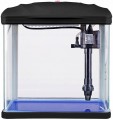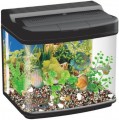Shape
The shape of the aquarium determines primarily its appearance and suitability for installation in one place or another. Accordingly, when choosing according to this indicator, it is quite possible to focus on your own aesthetic preferences, the design of the room in which the aquarium will be located, as well as the features of the installation site. At the same time, for some types of aquarium "animals" there are specific recommendations on the optimal shape: for example, spherical containers are poorly suited for bottom and bottom dwellers due to the small bottom area. Therefore, before choosing the form, it's ok to also decide on the “population” and clarify the conditions that are optimal for the selected species of animals and plants.
— Parallelepiped. The classic shape, also colloquially called
"rectangular" : all the edges of such an aquarium are flat and really are rectangles. Such tanks are easy to manufacture and inexpensive, while being quite versatile, suitable for almost all types of flora and fauna, and many professional aquarists prefer rectangles.
—
Cube. In fact, these aquariums are a kind of parallelepipeds described above, with the difference that the height, width and depth of the tank are the same in this case. Cubes are a rather specific variety, they are rare and usually have a small volume (up to jig for one fish).
—
Sphere.... Round aquariums, usually all-glass (see "Construction"). For installation, both a special stand and a small plane at the base of the “can”, which also plays the role of the bottom, can be used. The size of this plane is small, which, on the one hand, allows you to put the aquarium on small areas (much smaller than the diameter), on the other hand, it makes it difficult to keep fish that need a large area at the bottom. In addition, the volume of round models usually does not exceed a couple of tens of liters, which makes it difficult to maintain the necessary microclimate; and curved glass creates distortion when viewed.
— Oval. Oval aquariums are similar in shape to parallelepipeds (see above), except that the front wall is made convex. This improves visibility and visually increases the size of the aquarium, and in terms of overall design, such models are sometimes more preferable than "rectangles" (although they are somewhat more expensive).
— Hexagonal. Another modification of parallelepiped aquariums (see above): usually a hexagonal tank looks like two front corners were cut off from a rectangular aquarium, adding two additional edges. Like the oval ones described above, such “banks” provide a better overview and have an original appearance; however, this appearance is much rougher and does not fit into every interior, so hexagonal aquariums are less common.
— Half circle. Aquarium in the form of a half cylinder — the back wall has a flat shape, and the other wall is made in the form of a solid semicircular surface. This not only gives the container an original appearance, but also provides an equally convenient view from almost any direction within 180 °. On the other hand, semi-circular aquariums are not cheap, and the real need for such a shape is relatively rare.
— Pentagonal. Pentagonal aquariums are usually intended for installation in a corner: the two back walls converge at a right angle and, when installed, are closely adjacent to the walls of the room, and three more edges are located between them. This provides a better view than corner tanks (see below) with a flat front; and the advantage over corner models with a curved front wall is a slightly lower cost.
— Corner. This category includes all aquariums designed for installation in a corner and not related to pentagons (see above). A common feature of all corner models are two flat rear walls installed at an angle of 90 ° to each other; the front part can be flat, concave, multifaceted, etc.Volume
The nominal volume of the aquarium is one of the key indicators when choosing it.
The larger the "bank" — the more fish and other living creatures can be settled in it, the better it is suitable for large inhabitants. At the same time, professional aquarists proceed from the fact that “there is never a lot of volume” — after all, even the largest of home aquariums are much smaller than natural reservoirs. Therefore, when choosing by volume, usually, we are talking about the minimum required capacity. It can be found out by determining the planned composition and number of the "population" and specifying the conditions for their maintenance — data on this can be found in special sources.
In addition, the value of the volume lies in the fact that the larger the aquarium, the easier it is to maintain a constant microclimate in it, the less it is subject to temperature fluctuations due to changes in environmental conditions. Therefore, beginner aquarists are not recommended to purchase small containers — they require special care in maintaining the temperature.
Also note that the volume can be specified in different ways. So, some manufacturers consider the capacity in terms of dimensions and give the full volume, others — the working volume (that is, the maximum amount of water that makes sense to pour in fact), others — the required amount of water, taking into account the soil and decorations supplied in the kit, etc. P. However, more often than n...ot, the differences between models with the same claimed volume are very small.
Glass material
Composition of glass used for aquarium walls.
—
Silicate glass. Classical glass, similar in composition to that used, for example, for windows. It is distinguished by hardness, resistance to scratches and chemicals, due to which it practically does not become cloudy over time — except perhaps from pollution, but if necessary, they can be removed without any special fear even with abrasive or potent compounds. The reverse side of hardness is brittleness — from a strong impact, silicate glass easily breaks into fragments. Therefore, such aquariums are not recommended for use in places of "high risk" (such as kindergartens).
—
Plexiglas. Transparent polymer, also known as "acrylic glass" or "plexiglass". It is a kind of opposite to silicate glass: it is safe, perfectly resists concussions and even cracks from a strong blow, and does not crumble into fragments. On the other hand, plexiglass is easily scratched, so it requires delicacy when cleaning and inevitably becomes cloudy over time.
In box
Items supplied with the aquarium other than the vessel itself. Many additional accessories for the "bank" can be purchased separately. However, their presence in the kit, firstly, eliminates the hassle of finding and purchasing, and secondly, it guarantees optimal compatibility with this particular aquarium model — both in terms of performance and installation features.
—
Filter. The filter is a must for almost any aquarium: it purifies the water from mechanical impurities, waste products of fish and other contaminants. In addition, some filters can be connected to a compressor, oxygenating the water (see below).
—
Lid. The lid that closes the top of the aquarium can perform many functions. Initially, it is intended to protect the water from pollution, slow down its evaporation and prevent the inhabitants of the aquarium from jumping out. In addition, a lighting system and other additional equipment (for example, automatic feeders) are often built into the lid. And for access to the internal volume of the aquarium (for example, for the purpose of feeding) in large covers that are difficult to remove every time, hatches are usually provided.
—
Illumination system. A separate lighting system, often built into the lid (see above). Many fish and plants need bright light to function normally, which is difficult to provide indoors with natural or ro
...om lighting. In addition, the backlight gives the aquarium a pleasant appearance, allowing you to better view its contents. At the same time, critical electronic parts have enhanced protection against moisture, which is why special lighting systems are definitely more preferable than improvised designs.
— Thermostat. This term can mean different types of equipment: for example, even ordinary heaters can be called a thermostat for advertising purposes (see below). However, most often we are talking not only about the heater, but also about additional equipment — a manual power regulator or even a thermostat that allows you to automatically maintain the set temperature. The specific equipment and functionality of the thermostat in each case should be specified separately.
— Heater. Device for heating water. In many rooms where aquariums are set up, the temperature is much lower than necessary — especially since many aquarium fish come from tropical regions and are very thermophilic. To create the necessary conditions, you need to use special heaters; they are also sold separately, but most often it is more convenient to buy a heater together with an aquarium — a complete device will be optimally suited in terms of power and installation features.
— Dampers. The purpose of the shutters is similar to the lid described above: they cover the aquarium from above, protecting the water from pollution and preventing the inhabitants from jumping out, and are also used to install various equipment. In some cases, more compact shutters may be preferable to a lid, both from a practical and aesthetic point of view.
— Compressor. The compressor is designed to supply air to the aquarium. This is one of the most important devices that is necessary for almost any “can”: oxygen, which is dissolved in water in a natural way and produced by plants, is most often not enough for the normal life of fish, and the water needs to be additionally “blown through”. In addition, some filters (see above) are connected specifically to the compressor for operation. Compressors can be installed outside or inside the aquarium; the second variety is also called aerators, it is relatively rare.
— Pump. The pump can be used for different purposes: one of the most popular options is pumping water through a filter, but other applications are also possible (pumping out water when replacing it, creating an artificial flow, etc.). Features of the use of the pump in each case should be clarified separately.
— The background. An image superimposed on the back wall (walls) of the aquarium — in such a way that not wallpaper on the wall shines through the water column, but, for example, a drawing with an underwater landscape. The background plays an exclusively decorative role; the aquarium itself most often plays the same role, so this accessory can be useful for many aquarists. However, the background can be arranged independently by choosing a pattern at your own discretion and without relying on the choice of the aquarium manufacturer; Therefore, this configuration option did not receive much popularity.
— Cabinet. A special stand for setting up an aquarium, optimally suited to its size. The pedestal will be especially useful if there is no furniture at the intended installation site and no furniture is planned on which the aquarium could be installed. But in cramped conditions, when there is not much space on the floor, it may be redundant.
In addition to the above, other accessories may be included in the aquarium package: substrate (soil or pebbles), artificial plants, decorations, fish food, etc.
